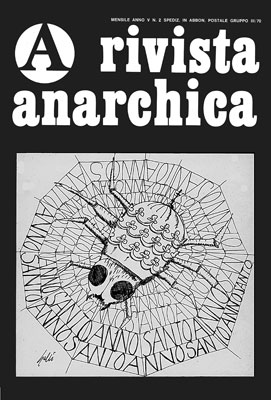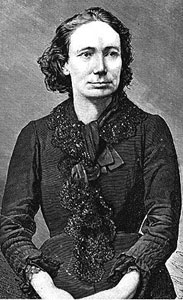
-
Thirtyseven
Years ago

by the editorial staff
"Roman Catholic Apostolic Church SpA" is the title of the opening of the n. 36 (March 1975) of "A". Even the cover is dedicated to the church, the Holy Year. Beyond its folkloric aspects shabbily - reads in part sommarietto signed by R. Brosio (Roberto Ambrosoli) - Holy Year once again in all its topical problem of the function and power of the Catholic Church. The "corporation" of Pope Montini controls a huge turnover and nevertheless continues to exert a harmful effect on millions of consciences. The validity of our anti-clericalism.
 A.B.
(Amedeo Bertolo) analyzes "the fear instrumentalized",
ie the role of mass media nell'incutere uncertainty and even
fear among citizens in terms of personal safety and public
order. A part of the paper is devoted to the effects of media
campaigns on the working class and women.
A.B.
(Amedeo Bertolo) analyzes "the fear instrumentalized",
ie the role of mass media nell'incutere uncertainty and even
fear among citizens in terms of personal safety and public
order. A part of the paper is devoted to the effects of media
campaigns on the working class and women.Emilio Cipriano (Luciano Lanza) is in charge of economic policy scenarios. His article "Cefis, for example" (eye: The rise to power of tecnoburocrazia) concludes: The bureaucrats of public companies are developing an intensive action to extend and consolidate their power, thereby creating the conditions for fusion of political power with the economy, a phenomenon which is not secondary, and that poses major questions about how the revolutionary struggle in Italy today. To all this we must respond appropriately, otherwise the failure of our action. Back then, once again, the insistence on the theme of tecnoburocrazia, "new class" which, with its gradual rise of class change scenarios: a constant in the early years of "A" in consonance with the analyzes made in those years by Federated Anarchist Groups.
Giampietro "Nico" Berti ("From the necessity to freedom") deals with the different approaches of anarchism and Marxism to the question of science.
The Committee Libertarian Spain ("Repression is not the same for all") interview the lawyer Francesco Piscopo, who has followed in Madrid - along with other lawyers "foreigners" - the process of Madrid against anarcho-syndicalists 4 victims of a political frame court-by the Franco regime.
Other issues discussed: the situation of the printing system, in an interview on his book The Corrado Stajano subversive dedicated to the story of young anarchist Serantini Franco, a biography of the anarchist Louise Michel French 800 (all three signed, in various so, by Paolo Finzi), another written Ambrosoli this time on "decrees" in the school, two reviews of magazines and some libertarian "chronicles subversive".
Ultimately, this issue contains the usual interesting mix of news, a bit 'of history, anarchist theory. But once all articles are written by the editorial staff of the usual suspects. The "other" space only found in small page of post.
37 years later, the difference with the magazine in your hand is impressive. Just take a look at the contents.
